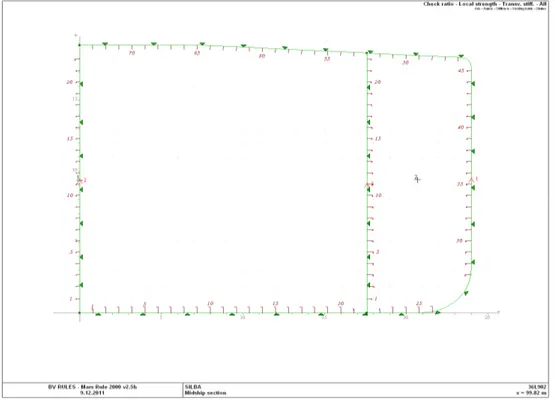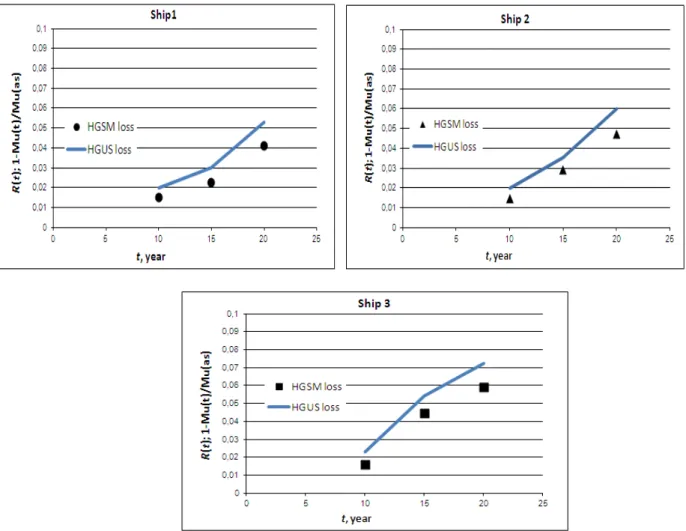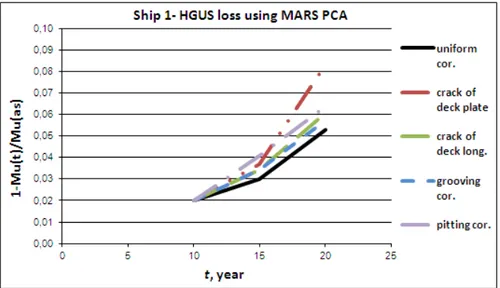Paul JURIŠIĆ, Hrvatski registar brodova, Marasovićeva 67, HR-21000 Split, Hrvatska, paul.jurisic@crs.hr
Joško PARUNOV, Faculty of Mechanical Engineering and Naval Architecture, University of Zagreb, Ivana Lučića 5, HR-10000 Zagreb, Croatia, jparunov@fsb.hr
HULL GIRDER ULTIMATE STRENGTH OF AGING OIL TANKERS
Abstract
Corrosion wastage and fatigue cracks are the most important causes of structural degradation of aging ships. General corrosion uniformly reduces thickness of structural elements and structural strength may be evaluated based on such reduced scantlings. In this paper, effect of uniform corrosion on hull girder ultimate strength (HGUS) of three oil tankers is assessed based on thickness measurement reports after 10, 15 and 20 years. The effects of non-uniform corrosion and fatigue cracks are approximately simulated by reducing affected cross-sectional area to evaluate their impact on the ultimate strength. Ultimate longitudinal strength is calculated by progressive collapse analysis using program MARS while results are compared to the IMO requirements.
Key words: ultimate strength, corrosion, thickness measurements, fatigue cracks
GRANI
Č
NA
Č
VRSTO
Ć
A TRUPA KORODIRANIH NAFTNIH TANKERA
Sažetak
Korozijska istrošenja i zamorne pukotine su jedan od glavnih razloga kolapsa konstrukcije trupa kod ostarjelih brodova. Pod djelovanjem opće korozije dolazi do smanjenja debljina elemenata trupa, a samim tim i smanjenja momenta otpora glavnog rebra, koja uzrokuju pad nosivosti brodske konstrukcije. U ovom radu analiziran je utjecaj opće korozije na graničnu čvrstoću tri naftna tankera na temelju izvještaja o mjerenju debljina nakon 10, 15 i 20 godina. Nejednolika korozija i zamorne pukotine su približno simulirane smanjenjem geometrijskih karakteristika poprečnog presjeka trupa u svrhu procijene njihovog utjecaja na graničnu čvrstoću. Granična uzdužna čvrstoća je provjerena na temelju metode progresivnog kolapsa (PCA) upotrebom programa MARS klasifikacijskog zavoda Bureau Veritas i završno rezultati proračuna su uspoređeni s važećim IMO zahtjevima.
1. Introduction
The corrosion makes ships prone to structural degradation and the possibility of accidents increases with the aging of ships. Statistical analyses reveal that corrosion degradation is the number one cause for structural casualties in aged ships. The International Maritime Organization (IMO), classification societies and ship owners continue to seek acceptable standards for structural integrity of aging ships with respect to repair and maintenance costs incurred over the ship life cycle [1], [2], [3].
The mechanisms of corrosion wastage can be divided into several different types of corrosion of mild and low alloy steels in marine environments such as uniform (general) corrosion, pitting and grooving. Initiation and progression of marine corrosion may be related to corrosive effects such as electrochemical, galvanic, erosion actions, etc. Localized corrosion can cause oil or gas leaks, while the general is more likely to lead to structural strength problems. The consequences of corrosion wastage can be very serious in some cases leading to damage of such extent to cause the loss of ship [4], [5].
Hull girder section modulus (HGSM) is a fundamental descriptor of the ship longitudinal strength and can be used to measure how the ship hull strength deteriorates over time because of corrosion. The time for repair of aged ships is empirically determined by the Classification Societies, based on existing criteria of damage allowance. One of the most important criteria is the so-called "10% rule", which represents tolerated 10% loss from initial as-built HGSM [6], [7].
Ship's structure in exploitation is exposed to the various loads such as hydrostatic pressure, static and dynamic pressure of cargo carried, the wave loads and vibration loads as whipping [3]. During navigation the ship hull is deformed (sagging and hogging), and in these conditions the maximum stresses suffer structural elements that are farthest from the neutral axis of the cross section of the ship (deck and bottom). Therefore, there is a danger that when the stress in these elements exceeds the yield strength of materials, they experience plastic deformations, and they consequently are no longer able to carry the applied load. Overstressed structural elements then collapse and may further cause global collapse of the main deck or the bottom. This could result in a fracture of cross-section in the middle of the ship's hull. Therefore, the problem of the ultimate capacity of the cross section, also known as the ultimate strength of the ship hull, becomes an inevitable segment in the calculation of the ship strength [8].
Recently, based on some major ship accidents, numerous research studies and public pressure as well, the approach for longitudinal strength assessment through HGSM of new-built ships started to be complemented by the hull girder ultimate strength (HGUS) assessment, as a physically justified criterion for entire capacity of the ship hull. The logical continuation of this approach in further research is that for the aged ships HGUS is used as a criterion of structural adequacy. The results of such approach were used in this paper [9].
The incremental-iterative method for the assessment of the ultimate longitudinal capacity of hull structure is used, that is implemented in Bureau Veritas software MARS [10]. The method of the progressive collapse is in the accordance with the requirements of CSR [1]. The ultimate strength of ship will be gradually reduced due to degradations effect of uniform corrosion, as shown in the first part of the paper. The purpose of remaining part of this paper is to get insight what could happen with the ultimate strength of ship hull girder under the additional degradation effects of non-uniform corrosion and fatigue cracks. Simplified approach for taking into account localized effects corrosion and fatigue cracks, proposed in ref. [2] is used in the present analysis. The HGUS of three single-hull oil tankers is studied, but the proposed methodology can be also applicable to the double-hull tankers [11], [12].
2. Description of ships
The corrosion wastage of three oil tankers with a single-hull structure, built in the eighties, is used in the paper for the HGUS analysis. The whole cargo area is made of mild steel for the two sister ships (ships no. 2 & 3), while the third one (ship no.1) was built of high tensile steel in the bottom and deck areas and mild steel in the neutral axis area including longitudinal bulkheads. Main particulars of the three oil tankers are shown in Table 1. The central tanks along cargo hold areas are cargo oil tanks, while the wing tanks can serve as ballast or cargo oil tanks. Main deck longitudinals of ship no. 1 are T-profiles while deck longitudinals of the sister ships are flat bars. Table 7. Main characteristic of three single-hull tankers
Tablica 1. Glavne karakteristike tri tankera s jednostrukom oplatom
ship no. 1 ship no.2 ship no.3
Length Lpp 237 m 205 m 205 m
Breadth B 42 m 48 m 48 m
Depth D 20.5 m 19 m 19 m
Draught T 13 m 13 m 13 m
Deadweight DWT 78,000 tons 80,000 tons 80,000 tons
3. Assessment of HGSM loss
The assessment of the HGSM loss is performed based on the following procedure. First, the as-built HGSM is calculated. Then, thickness of structural elements (plates and longitudinals) contributing to the longitudinal strength are modified according to the results of thickness measurements from Croatian Register of Shipping (CRS) file. Gauging records were performed on periodic dry-dockings and close-up surveys of ships in service after 10, 15 and 20 years. Corrosion model of the ships was performed for the transverse sections with combination of central tanks as cargo oil tanks and wing tanks as ballast tanks.
The aging effect is measured by the HGSM loss, which is the ratio of the as-gauged HGSM over the as built [13], [14]:
) _ ( / ) _ _ _ _ ( 1 )
(t HGSM as gauged at year t HGSM as built
R = − (1)
Results for measured R(t) for three ships after 10, 15 and 20 years are presented in the Table 2. Table 2.Measured aging effect R(t) for three analysed ships
Tablica 2. Izmjereni utjecaj starenja R(t) za tri analizirana broda
Years of measured R(t)-Ship 1 R(t)-Ship 2 R(t)-Ship 3
10 0.015 0.014 0.016
15 0.022 0.029 0.044
20 0.041 0.047 0.059
4. Assessment of hull girder ultimate strength due to effect of uniform corrosion
the ship hull curvature as beam. Iterative procedure in each step increases the curvature of the hull and obtains the new position of the neutral axis. This new position of the neutral axis is obtained from the equilibrium condition that the sum of forces acting on the elements above the neutral axis is equal to the sum of the forces acting on the elements below the neutral axis. At the end of each step the bending moment is calculated by summing the contributions to bending moment of each element [1].
The HGUS of three oil tankers is studied. The analysis is performed firstly for the initial as-built structure and then for reduced structural scantlings subjected to uniform corrosion, measured at 10th, 15th and 20th year of service. In the present paper, HGUSs in cargo space are calculated by the program for the 2D sectional analysis MARS of classification society Bureau Veritas (BV) [10]. MARS model of midship section of tankers is presented in Fig. 1.
Fig. 10. Midship section of single-hull oil tankers modelled using the program MARS
Slika 1. Glavno rebro tankera s jednostrukom oplatom modelirano upotrebom programa MARS
The result of HGSMs loss and HGUSs loss obtained using PCA method calculation for uniform corrosion are summarised in the Figure 2.
Fig. 2. Measured HGSM losses and calculated HGUS losses for: Ship no.1 (upper left); Ship no.2 (upper right); and Ship no. 3 (bottom)
Slika 2. Izmjereni gubitak momenta otpora glavnog rebra i izračunati gubitak granične čvrstoće za: Brod br.1 (gore lijevo); Brod br.2 (gore desno) i Brod br. 3 (u dnu)
Based on the comparison of the effect of general (uniform) corrosion for all three models from Fig.2 (Ship 1, Ship 2, Ship 3), it can be concluded that after the hull surveys at 10, 15 and 20 years there was not any reduction in the longitudinal strength of more than 10%, that is acceptable reduction in accordance with the IMO requirements [7], [15]. In all three ships this 10% reduction could happen between 25 to 30 years, i.e. later than designed ship lifetime. It also may be seen that the loss of the HGUS expressed as percentage of the initial HGUS is always larger than loss of HGSM. Differences between two losses increase with the time, i.e. with the corrosion wastage [16].
5. Hull girder ultimate strength of aged ship due to effect of uneven (pitting and grooving) corrosion and fatigue crack
In this chapter HGUS under the effect of uneven corrosion wastages (grooving and pitting) and fatigue cracks is calculated. Simplified procedure proposed in ref.[2] is employed for that purpose.
The anticipated crack of deck longitudinals is simulated using program MARS in a way that on the model of the midship cross-section, see Fig.1, one longitudinal is excluded from the HGUS
corrosion. Additional thickness decrease is estimated based on collapse analysis of isolated deck plates with pitting corrosion [18]. The grooving, which occurs in the longitudinal welded joint of the web of deck longitudinal and the flange of deck longitudinal is modelled by neglecting thickness of deck longitudinal flange. It has to be noticed that uniform corrosion is added as function of time to each of described cases.
The results presented in Fig 3. confirmed that the degradation effects, such as uneven corrosion wastages (grooving and pitting) and cracks, could significantly reduce the ultimate strength of hull structure [2], [3].
It can be seen from Fig.3 that in the cases of deck plate crack and the pitting corrosion, the limit of HGUS with reference to the IMO "10%" requirement can be reached between 20-25 years. The lowest impact on the HGUS, according to the present study has "grooving" corrosion.
Fig. 3. Calculated HGUS losses for Ship no.1 due to uneven (pitting and grooving) corrosion and fatigue crack Slika 3. Izračunati gubitak granične čvrstoće za Brod br.1 uslijed djelovanja nejednolike korozije i zamornih pukotina 6. Conclusion
The analysis of HGUS is based on the existing thickness measurements of hull elements of three single-hull oil tankers built in eighties. Corrosion wastage is gauged on periodic dry-docking and close-up surveys of ships in service after 10, 15 and 20 years. The present study is performed in order to investigate different simple ways to incorporate aging effects in HGUS calculation. The calculation methods for HGUS of the "as-built" condition or uniform corrosion are relatively simple and follow the procedure described in the CSR. However, the calculation of the HGUS with different types of local damages due to aging effects is out of standards and simplified calculation methodology is proposed in this paper. Such approach is of high importance for classification societies to assess the structural safety of aged ships.
Following conclusions may be drawn:
1. For uniform corrosion, HGSM loss with respect to the as-built HGSM is always lower than HGUS loss with respect to the as-built HGUS (expressed in percentage of initial values), 2. The hull structures of observed ships are in accordance to IMO requirements through whole
design lifetime,
3. The local structural damages such as uneven corrosion and fatigue cracks are well redistributed on the hull elements and structural redundancy is achieved due to the applied load.
Implementation of presented research can be a useful tool for ship-owners and classification societies in the assessment of hull ultimate strength on next hull inspections [13], [14], [17].
References
[1] ...: American Bureau of Shipping, Det Norske Veritas, Lloyd's Register, "Common Structural Rules for Double Hull Oil Tankers", 2010.
[2] PAIK, J.K., THAYAMBALLI, A. K.: "Ship-shaped offshore installation: Design, Building and Operation", Cambridge University Press, New York (USA) 2007.
[3] HUGHES, O. S., PAIK, J.K.: "Ship structural analyses and design", Trans. SNAME, New Jersey 2010.
[4] WANG, G., BOON, B., BRENNAN, F. P., GARBATOV, Y., JI C, PARUNOV, J., RAHMAN, T. A., RIZZO, C., ROUHAN, A., SHIN, C. H., YAMAMOTO, N.: Report of Committee V.6 Condition Assessment of Aging Ships and Offshore Structures, 17th International Ship and Offshore Structures Congress, 16-21 August 2009, Seoul, Korea.
[5] JURIŠIĆ, P., PARUNOV, J., GARBATOV, Y.: "Comparative analysis based on two nonlinear corrosion models commonly used for prediction of structural degradation of oil tankers", Transactions of FAMENA, in press, 2014.
[6] WANG, G., LEE, A., IVANOV, L., LYNCH, T., SERRATELLA, C., BASU, R.: "A statistical investigation of time-variant hull girder strength of aging ships and coating life", Marine Structures, vol.21, pp 240-256;2008. [7] ...: IMO, "Guidelines on the enhanced programme of inspection during surveys of bulk carriers and oil tankers -
Resolution A.744 (18), Amendments 2000", London (UK) 2000.
[8] ŽIHA K., PARUNOV J., TUŠEK B.: "Granična čvrstoća brodskog trupa", Brodogradnja 58, pp 29-41; 2007.(in Croatian)
[9] PAIK, J.K, BRANNER, K., CHOO, Y., CZUJKO, J., FUJIKUBO, M., GORDO, J.M., PARMENTIER, G., IACCARION, R., NEIL, S., PASQUALIO, I., WANG, D., WNANG, X., ZHANG, S.: Report of Committee III.1 Ultimate Hull Girder Strength, 17th International Ship and Offshore Structures Congress, 16-21 August 2009, Seoul, Korea.
[10] ...: BUREAU VERITAS, "MARS software 2000", Paris (France) 2003.
[11] PARUNOV, J., ŽIHA, K., MAGE, P.: "Corrosion wastage of oil tankers-a case study of an aged ship", IMAM 2007, Guedes Soares & Kolev (ur.), Varna: Taylor & Francis Group, 2008. 271-276.
[12] GUEDES SOARES, C., PARUNOV, J.: "Structural Reliability of Suezmax oil tanker designed according to new joint tanker project rules", Journal of Offshore Mechanics and Arctic Engineering. 130 (2008), No.2; 17-27. [13] JURIŠIĆ, P. PARUNOV, J.: "Long-term prediction of global corrosion wastage of oil tankers", SORTA,
Korčula 2010.
[14] JURIŠIĆ, P. PARUNOV, J., ŽIHA, K., "Uncertainty in corrosion wastage prediction of oil tankers", IMAM 2011, Guedes Soares & Rizzuto E., Genova: Taylor & Francis Group Vol.1, pp 395-401; 2011.
[15] PAIK, J.K., BRENNAN, F., CARLSEN, C.A., DALEY, C., GARBATOV, Y., IVANOV, L., RIZZO, C., SIMONSEN, B.C, YAMAMOTO, N., ZHUANG H.Z.: Report of Committee V.6 Condition Assessment of Aging Ships, 16th International Ship and Offshore Structures Congress, 20-25 August 2006, Southampton, UK. [16] PARUNOV, J., MAGE, P., GUEDES SOARES, C.: "Hull girder reliability of an aged oil tanker", Proceedings
of the 27th International Conference on Offshore Mechanics and Arctic Engineering. ASME. Estoril. Portugal, Paper no. 57183., 2007,
[17] PARUNOV, J., ŽIHA, K., MAGE, P.: "Corrosion wastage of oil tankers – a case study of an aged ship". In: Maritime Industry, Ocean Engineering and Coastal Resources. Guedes Soares & Kolev (ed.). Taylor & Francis Group. London. 271-276., 2008
[18] JURIŠIĆ, P.: "Utjecaj starenja na graničnu čvrstoću brodskog trupa", Ph.D. thesis, Doktorski rad FSB-Zagreb 2012 (in Croatian).



